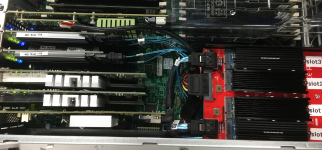I was in a bit of a rush, and wanted to circle back around to this. My own opinion, and I hope since I've written lots of the docs on this it should be clear I've been doing this for quite some time, is that it is far better to virtualize TrueNAS for general filesharing purposes, not VM hyperconverged hairpin storage.
Maybe it's just me 'cuz I'm old and no longer enjoy hefting 150# servers into racks by myself, but over the years I've kind of settled into building on the Supermicro SC826BA style chassis. This allows you to put in an LSI 3008 to handle 8 of the hotswap bays, and either mainboard SATA or mainboard PCH SCU to handle the other four, which means that you can actually have one or two virtualized TrueNAS hosts on the platform. This makes it easy to do independent primary, backup, and offsite filers with separate virtual instances, rather than playing the "how do we map replication targets" game.
For VM storage, as previously hinted at, I've had good luck with the Dell PERC controllers, and we started replacing the ESXi-deprecated LSI 6Gbps controllers with PERC H740P about two years(?) ago. The trick is that the card load we have is pretty dense, and no full length cards, so we mount a M.2 SATA SSD module inside behind the fan bulkhead capable of holding 4 or 8 M.2 SSD's. Looks like this

This is a very old picture, as you can tell from the PERC H200, Solarflare SFN6122's, LSI 9271CV-8i, and Addonics cards (2x SATA, 1x NVMe on each card).
Our more modern card stack replaces the PERC H200 with an LSI 3008 (Supermicro AOC-S3008L-L8i), replaces the two deprecated Solarflares with a single quad-port Intel X710-DA4 (Supermicro AOC-STG-I4S), pulls the two Addonics and quad M.4 module in favor of a carefully redesigned
Silverstone SDP11's stacked with standoffs for a total of eight SATA M.2 SSD's in about the size of a half height 5.25" HDD, and then with the remaining three PCIe slots now freed, some nice Supermicro AOC-SLG3-2M2 cards.
This lets you get six nonredundant NVMe SSD's and eight SATA SSD's in RAID1 inside a 2U chassis IN ADDITION TO the twelve drives that are part of the NAS VM (/VMs).
It's mostly standard hardware except for the Silverstones, which need some finicky spacers to get the right spacing to stack. You do have to drill three holes to attach them as well, but if anyone cares, I do have a drilling template.
What? You say I'm crazy? Well, that's as may be...

